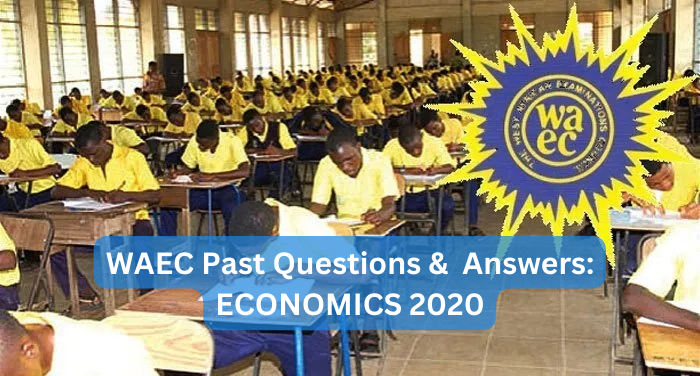WAEC Past Questions & Answer: ECONOMICS 2020

Welcome to our WAEC past question and answer series. In this post, we will be sharing Economics 2020 past questions and their answers for various subjects. Stay tuned enjoy while learning.
1. Which of the following is central to the definition of Economics?
A. resources
B. wants
C. scarcity
D. capital
2. When the production possibility curve shifts outwards, the economy experiences
A. growth
B. over-production
C. inefficient use of resources
D. under-production
3. Land as a factor of production is made useful through the
A. application of human effort
B. acts of nature
C. application of fertiliser
D. use of machines
4. In a free market economy, resources are allocated through the
A. government department
B. price mechanisms
C. trade union
D. state planning committee.
5. Use the figure below to answer question that follows
What does the diagram above depict
A. simple bar chart
B. complex bar chart
C. component bar chart
6. The figure below shows the change in demand for Commodity X which is a normal good. Use it to answer the question that follows.
Open Photo
Which of the following caused the change in demand from D1 D1 to D2D2
A. Fall in the income of consumers
B. Rise in the price of a substitute
C. Rise in the price of a complement
D. Fall in the supply of commodity X
7. Use the figure below to answer the question that follows
Open Photo
The curves D0D0 and S0S0 are the initial demand and supply curves respectively. What happens when government provides subsidies to producers?
A. The supply curve will shift from S0S2 to S2S0
B. The supply curve will shift from S0S0 to S1S1
C. The demand curve will shift from D0D0 to D1D1
D. The supply curve will shift from S0S0 to S0S0
8. Open Photo
In the figure above, YZ represents
A. excess demand
B. excess supply
C. equilibrium quantity
D. equilibrium price
9. Goods are described as inferior if their demand
A. decreases as price falls
B. increases as income rises
C. decreases as income increases
D. increases as price increases
10. A consumer is in equilibrium when
A. his market Supply is equal to his market demand
B. he maximizes his satisfaction from spending his income
C. the market is also in equilibrium
D. he has consumed all he wants
11. Goods that are abundant in supply usually have low
A. total utility
B. marginal utility
C. average utility
D. time utility
12. If an increase in the price of crude oil led to an increase in the prices of kerosene and grease, then kerosene and grease are in
A. joint supply
B. competitive supply
C. market Supply
D. composite supply
13. If an increase in the supply of beef increased the supply of hides, then beef and hides are in
A. competitive supply
B. joint supply.
C. composite supply
D. joint demand
14. An increase in supply means that
A. more is sold at different prices
B. more is sold at the same price
C. there is a leftward shift of the supply curve
D. there is a movement along the supply curve
15. A seller increased the quantity he offered for sale from 200 units to 250 units when the price of his product increased by 12.5%. What is the price elasticity of the supply of his product?
A. 2.00
B. 1.50
C. 1.00
D. 0.50
16. If a beef market is in equilibrium at $4.00 per kg, an increase in price to $6.00 per kg may cause
A. surplus in the market
B. shortage in the in market
C. black market to come into operation
D. rationing to be introduced
17. A large firm may experience diseconomies of scale if there is
A. difficulty in coordinating decisions
B. division of labor in production
C. employment of more specialist
D. decrease in the cost of production
18. Increasing returns to scale suggests that
A. a firm can make a profit by reducing output
B. a firm can make more profit by increasing output
C. as the producer reduces the quantity of raw materials used, the marginal product will double
D. as the producer increases the quantity of raw materials used, the marginal product will fall
19. One feature of the average fixed cost is that it
A. falls continuously but is never equal to zero.
B. is U-shaped and intersects the Y-axis
C. rises and falls faster than the marginal cost
D. is always higher than the average variable cost
20. If the average fixed cost (AFC) of producing 5 bags of rice is $20.00, the average fixed cost of producing 10 bags will be
A. $2.00
B. $4.00
C. $10.00
D. $20.00
21. The table below shows the total revenue schedule of a firm. Use the information to answer the question that follows
Output (units) 50 60 70 80 90
Total revenue (TR) $ 85 102 119 136 153
What is the unit price of the firm’s output
A. $10.00
B. $2.70
C. $2.00
D. $1.70
22. The table below shows the total revenue schedule of a firm. Use the information to answer the question that follows
Output (units) 50 60 70 80 90
Total revenue (TR) $ 85 102 119 136 153
What is the firm’s marginal revenue?
A. $153.00
B. $17.00
C. $1.70
D. $O.80
23. Organization and entrepreneurship are vested in different persons in a
A. cooperative society
B. sole proprietorship
C. partnership
D. public company.
24. The public sector in a mixed economy is not always because of
A. bureaucratic practice
B. the desire to make huge change
C. annual planning of activities
C. the activities of shareholders
25. Which function of the wholesaler enables him to stabilize prices?
A. Warehousing goods
B. Advertising the goods
C. Granting credit to retailers
D. Transporting goods
26. In the long run, as individuals receive higher wages, it causes
A. demand for food to decrease
B. demand for leisure to decrease
C. supply of normal goods to decrease
D. supply of labour to decrease
27. Labor productivity is defined as
A. output per man-hour
B. average Output
C. the maximum number of hours Worked
D. total output of labour
28. Which of the following problem has the least effect on agricultural productivity in West Africa?
A. Incidence of pests and diseases
B. Unfavourable weather conditions
C. Urban-rural migration
D. Illiteracy
29. The location of iron and steel industry at a place is due to
A. easy access to raw materials
B. access to cheap labour
C. government policy
D. good infrastructure
30. Import substitution as a strategy of industrialisation is the
A. replacement of locally produced goods with imported ones
B. development of locally produced goods with imported ones
C. establishment of firms to process imported raw materials
D. act of using local inputs to produce goods for export
31. Which of the following are intermediate products?
A. Cement and steel
B. Furniture and shirt
C. Handkerchief and shoe
D. Table and door
32. How is NNP at factor cost derived from GNP at market prices?
A. GNP – Depreciation + Indirect taxes + Subsidies
B. GNP Depreciation – Indirect taxes + Subsidies
C. GNP + Depreciation Indirect taxes – Subsidies
D. GNP+ Depreciation- Indirect taxes + Subsidies
33. Inflation may occur if
A. rate of productivity is higher than the wage rate
B. prices fluctuate during a particular season of the year
C. wage increase is granted without an increase in productivity
D. the government embarks on restrictive monetary policies
34. Money would cease to be a good store of value when
A. prices of goods and services are falling slowly
B. there is a high level of unemployment
C. prices of goods and services are rising rapidly
D. prices of goods and services are rising slowing
35. Which of the following factors may lead to the underestimation of national income figures?
A. Availability of skilled statisticians
B. High volume of exports
C. Emigration of skilled workers to foreign countries
D. Subsistence production
36. Governments in West Africa can curtail inflation by
A. purchasing securities in the open market
B. selling securities in the open market
C. encouraging importation of goods from all countries
D. encouraging banks to lend for
37. The central bank Can reduce the ability of commercial banks to give out loans by
A. raising the bank rates
B. reducing special deposits
C. reducing the liquidity ratio
D. issuing more currency
38. Tools of monetary policy do not include
A. open market operations
B. reserve requirement
C. bank rate
D. tax and public expenditure
39. During inflation, the appropriate fiscal measure to adopt is to
A. increase indirect taxes
B. increase direct taxes
C. reduce personal income tax
D. increase government expenditure
40. Mr. X and Mrs. Y pay $500.00 and $1,400.00 as taxes on their earning of S5,000.00 and $7,000.00 respectively. The system of taxation employed is
A. specific tax
B. proportional tax
C. regressive tax
D. progressive tax
41. Expenditure on food takes a large proportion of the incomes of people in
A. industrialised countries
B. advanced countries
C. developing countries
D. capitalist countries
42. A country should embark on development planning to ensure that
A. it becomes popular among the comity of nations
B. it also does what others are doing
C. its scarce productive resources are efficiently utilised
D. the nation is able to contribute its own quota to international organisations.
43. A country is allowed to import just 50,000 tonnes of rice annually. This describes
A. devaluation
B. tariff
C. embargo
D. quota
44. Dumping is selling goods in a foreign market at a price
A. below what is sold at the home market
B. above what is sold at the home market.
C. equal to what is sold at the home market
D. equal to the cost of producing the goods
45. The principle of comparative advantage encourages a country to
A. produce only consumer goods
B. engage in trade if it can produce a commodity at a lower cost
C. specializes in the production of all goods
D. try as much as possible to be self-sufficient
46. The foremost objective of the International Bank of Reconstruction and Development (IBRD) is to
A. help promote private and public investments
B. assist members achieve a balance of payments stability
C. grant long term loans for infrastructure
D. maintain stability of foreign exchange
47. In order to discourage the importation of manufactured goods, a country should adopt
A. import promotion strategy
B. export led strategy
C. liberal foreign exchange
D. import substitution strategy
48. Free trade is one in which
A. each member operates its own barriers against non-members
B. factors of production are mobile
C. members adopt a common external tariff against non- members
D. members adopt common fiscal and economic policies
49. The exploitation of mineral resources constitutes which form of production?
A. Primary production
B. Secondary production
C. Tertiary production
D. Services production
50. Which function of the wholesaler enables him to stabilize prices?
A. Warehousing goods
B. Advertising the goods
C. Granting credit to retailers
D. Transporting goods
Answers To Questions
- C
- A
- A
- B
- C
- B
- B
- B
- C
- B
- B
- A
- B
- B
- A
- A
- A
- B
- A
- A
- D
- C
- D
- A
- A
- A
- A
- D
- A
- B
- A
- D
- C
- C
- C
- B
- A
- D
- B
- D
- C
- C
- D
- A
- B
- C
- C
- B
- A
- A





